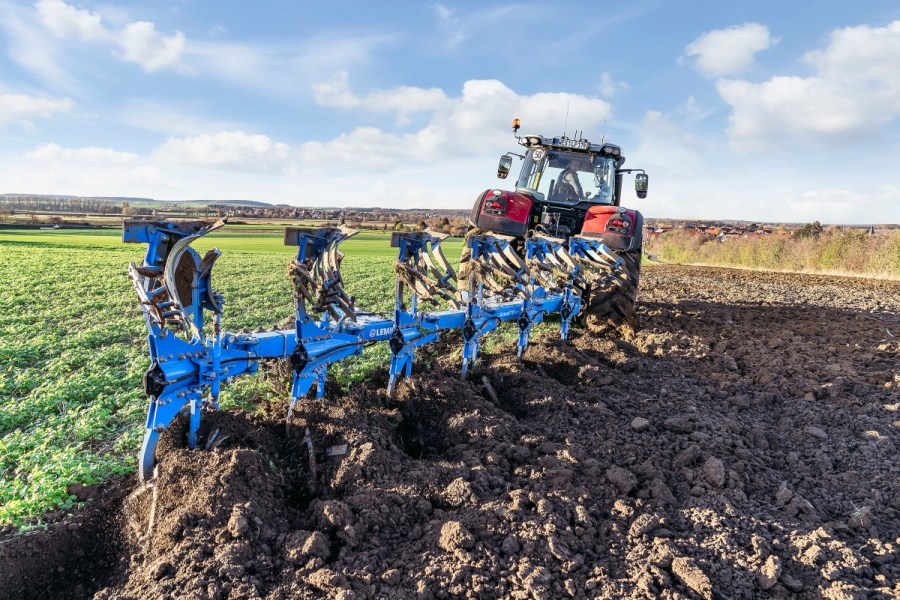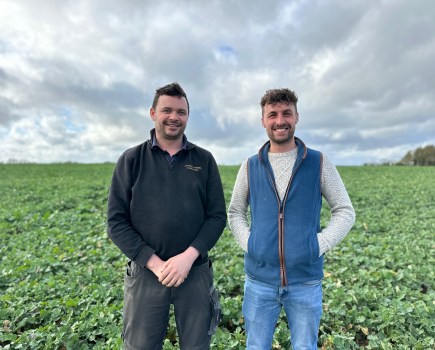With a seismic shift towards reduced soil movement, is there still a place for the plough in the arable rotation? CPM finds out why this is the case for one Essex grower.
It makes our system so much more flexible.
By Rob Jones
In an era where minimum tillage is in vogue, the humble plough has somewhat fallen out of the spotlight.
However, that’s not to say it doesn’t have an important place within arable systems for many…
Such is the case for Essex farmer, Douglas McTurk, who says ploughing is the main cultivation operation on his arable farming enterprise where roots are a key part of the rotation.
T W Salmon and Co Slough Farm, Ardleigh is a 283ha light land farm that follows a predominantly winter cultivation regime and supports winter wheat, spring and winter barley, oilseed rape, sugar beet, and maize for a local biogas plant. Land is also rented out for potatoes and onions.
Sandy loam soils mean that cultivations are based on the plough followed by a tine drill. Soils are prone to drying out so fields are rolled to retain moisture where appropriate, says Douglas.
“Our soils are predisposed to consolidation and surface compaction which means we have to have a plough in the rotation sometimes. That said, we don’t always need it because we direct drill OSR and can get away with sub disking after roots if the conditions are right. On our light land the plough is a cheaper way to create a seedbed. To go down the min-till route might be faster, but it’s more passes and more machinery.”
When it comes to selecting a plough for the task in hand, Douglas says the primary cultivator must be robust to withstand a heavy workload and offer operation flexibility if it is to fit into the programme.
And for him, the plough that offers this is a variable width mounted Juwel 8 MV from Lemken.
“We ran a competitor plough for nine years prior to switching to Lemken,” says Douglas. “Ploughing might appear a simple operation but, to do the job properly, it needs a skilled operator. Modern ploughs are sophisticated implements.”
Following a demo of Lemken’s Juwel 8 MV mounted plough on farm, Douglas says he immediately liked it because of its new hydraulically operated variwidth furrow press, the FlexPack.
“The FlexPack is integral to the plough and because it’s variable width it is ideal for going around field obstacles,” he explains. “It’s not until you have tried a plough with a variable width integrated press that you realise how much time and effort it saves not having to manoeuvre around objects, such as telegraph poles and trees.
“There’s no risk of double packing overlaps when it’s being used at reduced working widths, which guarantees uniform soil reconsolidation.”
The FlexPack also only takes 10 minutes to take off or put back on, he adds. “Being able to quickly take it off is ideal for winter ploughing. Our previous machine’s press was also easy to take off but it was always a problem putting it back on again, often taking over an hour.”
Douglas’ own Juwel 8 MV, kitted out with a serrated disc coulter, only arrived on farm last September but has already been put to the test, he explains.
“The FlexPack and variwidth features have already paid dividends. In wet conditions we can close up each furrow to only 30cm, which allows us to continue cultivating. With time availability at a premium, it makes our system so much more flexible and gives us extra capacity to potentially take on more contract work.”
On the headland the benefits of these two features on the Juwel 8 MV have also come into their own, he adds.
“We can now press everything that has been ploughed as opposed to having to leave a section of the first pass unpressed, which was the case with our previous plough and press arrangement.”
The plough at Slough Farm is pulled by a Case Optum 270 cvx, which is more than enough horsepower to cultivate at 3.3m, he explains.
When the tractor is up for changing Douglas says he might take one furrow off the plough and extend it to its full working width. This would lighten the plough weight and reduce the horsepower needed to pull it by 40-50hp.
“The Juwel plough has improved cultivation efficiency by at least 15%,” he says. “In order to plough and press the same area with our previous plough we would have had to put on extra press rings.”
Douglas says that he has been impressed with Lemken’s hard faced points too. Despite some abrasive soils on the farm, he has not had to change them yet and it’s claimed DuraMaxx parts are manufactured from harder steel, giving 50% improved performance.
“Our Juwel plough came with the hard faced points on it so we haven’t been able to compare the cost with a standard alternative,” says Douglas “When we’ve completed a full season we will have a better idea of the harder point’s performance. What we do know at this stage is that standard points would have been changed three times over 283ha.”
According Lemken’s Paul Creasy, DuraMaxx is a completely new plough body concept. “As Douglas says, performance time can be improved by 50% and we’ve estimated that the set-up time can be reduced by up to 80% too.
“Mould boards and slats are supported fully by the frog and other support structures. They’re no longer a load-bearing part of the plough body. This means they can be worn much thinner without the risk of snapping due to the soil forces on them.”
Douglas has the standard bolt on iron because it shouldn’t be necessary to change mouldboards/shins that often and he has the standard two bolt points because if a spanner is needed to change one bolt it makes sense to change both colts at the same time, therefore using much cheaper iron without clips, he explains.
Lemken has also built other easy and fast adjustments into its ploughs such as depth control. Two rams set the offset position and the front furrow is easy to adjust too, explains Paul.
“Furrow depth at the back is set by the depth wheel and it’s easy to feather the last furrow to only a couple of centimetres using a pin, which avoids leaving a deep furrow on the outside.”
However, Douglas says they shouldn’t need to make further adjustments once the plough is set up unless they are changing the tractor or tractor width. “We also have the Uniwheel with a hydraulic damper attached, allowing the depth wheel to move slowly and smoothly on turnover rather than crashing over.”
The Uniwheel allows a quick and simple change between working and transport position, explains Paul. “The working depth is easily adjusted using a pin without having to lift the Uniwheel. The plough is locked in the central position for transportation.”
Other neat features on the Juwel range include mechanical tilt adjustment which ensures vertical ploughing, or, optionally the Juwel 8/10M ploughs can also be equipped with a memory reversing mechanism with central tilt adjustment, he adds. “This allows tilt to be adjusted from the cab via a separate spool valve.”
Though it seems much of the industry is moving towards reduced soil movement, the investment in the Juwel range is testament to the fact that many farmers are still buying ploughs, notes Paul. “If you go on to Twitter or read an article about cultivations, everyone is talking about doing various forms of minimum tillage to promote to soil health. At an event like Groundswell, for example, to even say the word plough is a bad thing.
“However, farmers are still buying ploughs – showing the value they can have in the rotation.”
Much like a break crop is used every few years within a cropping plan, Paul says that he sees the plough playing a similar role going forward. “In terms future prospects, we’re not expecting to see the plough used every year – though this might be the only way for some farms. Instead, we see it as a rotation tool, largely to combat weed control.
“We’ve done a lot of work with Agrii over the years looking at cultivations, and what we’ve continuously found is that the plough can be a really useful reset button for cultural weed control, particularly where growers are facing resistant blackgrass issues, for example.”
That said, to get the benefits from ploughing, it has to be done in a strategic manner, he adds. “Ploughing can be slow and expensive – from both fuel perspective and on labour – so if you’re going to do it, you’ve got to do it correctly to see the benefits.
“A lot of people still see the plough as a fire-fighting tool if it’s too wet to do anything else, but the advice from me is that if you can’t pull a min-till cultivator at 15cm because it’s too wet, then you shouldn’t be ploughing either.
“It’s important to take a strategic approach and if you plough under good conditions, you’re more likely to minimise impact on the soil while ensuring that the seed goes into optimum conditions too.
“More often than not, we see poor ploughing done under sub-optimal conditions which often leaves grower disappointed from a soil perspective, or in the performance of the crop. But there are still areas where ploughing and furrow pressing combined is a very good way to produce clean effective seedbed for crop – it just requires a knowledge of how to the use the plough properly and an understanding of the art of when to plough.”
Extra protection
Users of Lemken’s Juwel, Diamant and Titan ploughs can now also benefit from the newly launched OptiStone automatic overload protection – a system designed to remove the barrier between ploughs and very stony soils.
“The new hydraulic overload protection is now even more stable and can avoid obstacles easily up to 38cm vertically and at the same time up to 20cm horizontally,” explains Paul.
So how does it work?
At the heart of the OptiStone is a closed system of highly stable leg plates, which are reliably protected against dirt and foreign objects, explains Paul. “A newly designed swivel bracket ensures high lateral tripping forces and optimal plough control in stony soils.
“When an obstacle is encountered, the overload element simultaneously deflects up to 37cm upwards and 20cm to the side. This provides for a sufficiently large range of deflection to ensure consistently disruption-free work, even with deep ploughing.
“The tripping forces can be continuously adjusted from the comfort of the driver’s seat to adapt to changing soil conditions. If the system catches below a slab of stone or roots, it’s additionally protected by a double-cut shear bolt to prevent damage to the plough.
One of the key advantages of the system is that it features high-strength radial spherical plain bearings to keep the plough bodies stable as the system deflects, he adds. “The plough bodies are firmly connected to the three-dimensional bearing points and therefore cannot unhitch – a clear advantage compared to the overload protection systems with four-point suspension commonly found on the market.
“The radial spherical plain bearing is durable, reliable and easily accessible for convenient maintenance.”
Farm facts
T W Salmon and Co Slough Farm, Ardleigh, Essex
- Arable area: 238ha
- Cropping: Winter wheat; spring and winter barley; oilseed rape; sugar beet; maize.
- Soil type: Light land
- Mainline tractors: Case IH Optum 270; Maxxum 135
- Combine: Case IH 6130
- Cultivation equipment: Lemken Juwel 8MV plough; Kvernland TS Evo drill.




